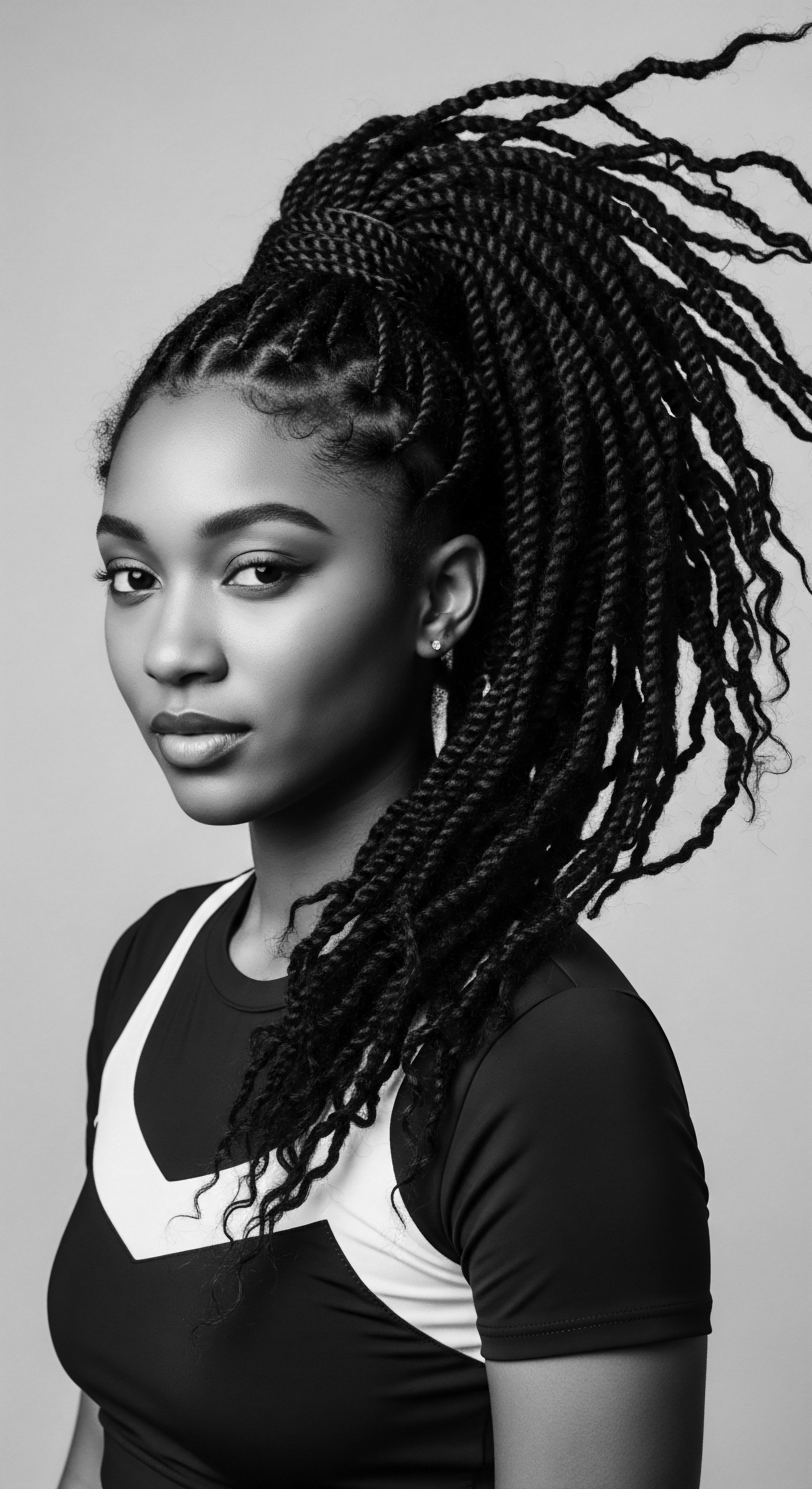
Fundamentals
The concept of Follicle Nutrition, at its most elemental, speaks to the sustenance required by the hair follicle—the living organ nestled within the skin from which each strand of hair emerges. This microscopic factory, a marvel of biological engineering, demands a consistent and specific supply of nutrients to function optimally. A healthy hair follicle, well-nourished from within, stands as the quiet architect of strong, resilient hair.
Without proper nourishment, this vital mechanism can falter, resulting in hair that appears fragile, grows slowly, or even thins over time. The fundamental idea centers on providing the body with the internal building blocks necessary for healthy hair growth, recognizing that topical applications, while beneficial, offer only one layer of care.
From the earliest moments of human understanding, our ancestors recognized the deep connection between inner well-being and outward vitality, with hair often serving as a visible testament to one’s health. Across various ancestral practices, a foundational belief persisted ❉ what sustains the body also sustains the hair. This understanding, while not articulated with the precise terminology of modern science, nevertheless guided care routines focused on holistic nourishment. The essence of Follicle Nutrition, then, is a timeless wisdom ❉ vibrant hair begins beneath the surface, sustained by a robust internal environment.

The Hair Follicle ❉ A Living Root
Each hair on our head originates from a hair follicle, a tiny, specialized structure that anchors the hair into the skin. This small organ is anything but simple; it possesses a complex network of blood vessels that deliver vital nutrients and oxygen, alongside nerve endings and sebaceous glands that produce the natural oils vital for hair and scalp health. The hair follicle cycles through distinct phases of growth, regression, and rest, a continuous process reliant upon sustained internal support. The integrity of this cycle, and the health of the resulting hair, depends directly on the nutritional support it receives.
Vibrant hair originates from a well-nourished follicle, a testament to the symbiotic relationship between internal health and external vitality.

Elemental Requirements for Growth
The hair follicle, a highly active metabolic site, requires a spectrum of essential nutrients to facilitate healthy hair production. These foundational elements work in concert, contributing to various aspects of hair structure and growth. A deficiency in even one of these components can compromise the follicle’s ability to perform its function.
- Proteins ❉ Hair itself is composed primarily of keratin, a fibrous protein. Adequate protein intake provides the amino acids necessary for keratin synthesis, acting as the fundamental building blocks for hair strength and elasticity.
- Vitamins ❉ A range of vitamins play distinct but complementary roles.
- Vitamin A ❉ Supports cell growth and the production of sebum, which moisturizes the scalp.
- B Vitamins (especially Biotin and B12) ❉ Crucial for cell division and metabolic processes within the follicle. Folate, another B vitamin, also helps with cell growth.
- Vitamin C ❉ An antioxidant that aids in collagen production, a structural component of hair, and supports iron absorption.
- Vitamin D ❉ Plays a role in hair follicle cycling and the creation of new follicles.
- Minerals ❉ These micronutrients are vital for numerous enzymatic reactions that support hair health.
- Iron ❉ Essential for oxygen transport to the hair follicle, a critical process for cellular energy and growth. Low iron stores can contribute to hair thinning.
- Zinc ❉ Supports hair tissue growth and repair, and helps keep the oil glands around the follicles working properly.
- Selenium ❉ An antioxidant involved in thyroid hormone metabolism, which can influence hair growth.
Understanding these foundational needs provides a straightforward lens through which to consider how our internal landscape shapes the very strands that adorn our heads. This basic recognition bridges ancient wisdom with contemporary scientific insights, revealing a continuous stream of knowledge about fostering hair health from its very source.

Intermediate
The description of Follicle Nutrition, moving beyond a rudimentary explanation, acknowledges the complex interplay between systemic health, cellular processes within the scalp, and the cultural practices that have historically sought to enhance hair vitality. It represents a dynamic equilibrium where internal sustenance, delivered through the bloodstream, meets the specialized needs of the hair matrix cells, which are among the fastest-growing cells in the human body. This integrated approach considers how macro and micronutrients fuel cellular proliferation, keratinization, and the pigment production that gives hair its distinctive color. The notion extends to the intricate dance of hormones, the subtle influences of stress, and the underlying genetic predispositions that collectively shape a follicle’s capacity for growth and resilience.
For textured hair, particularly within Black and mixed-race communities, the nuances of Follicle Nutrition carry an added layer of historical weight and cultural depth. Ancestral care traditions, often developed in environments where direct access to a wide array of commercial products was unavailable, instinctively addressed these nutritional needs through localized remedies and holistic lifestyle choices. These practices, passed down through generations, implicitly supported follicle health by nourishing the body and scalp with indigenous plants, oils, and dietary habits. The wisdom embedded in these traditions offers a powerful framework for understanding Follicle Nutrition not merely as a biological function but as a living legacy, a testament to ancestral ingenuity.

The Ecosystem of the Scalp and Follicle
The scalp acts as an intricate ecosystem, a foundation upon which hair grows. Its health directly correlates with the vibrancy of the hair follicles it houses. A balanced scalp environment, free from excessive inflammation or microbial imbalance, ensures optimal blood flow and nutrient delivery to the follicles. Conditions that compromise scalp health, such as excessive dryness, irritation, or persistent tension from certain hairstyles, can impede the follicle’s ability to receive the nourishment it requires, affecting hair quality and retention.
Ancestral hair practices, rooted in localized remedies and holistic living, intuitively supported follicle health, a testament to enduring wisdom.

Beyond Basic Nutrients ❉ Micronutrient Synergies
While a basic understanding of proteins, vitamins, and minerals lays the groundwork, an intermediate understanding of Follicle Nutrition delves into the synergistic actions of these micronutrients. It’s not just about the presence of a single nutrient, but how they interact and support each other’s absorption and efficacy.
For instance, Vitamin C facilitates the absorption of Iron, both critical for hair growth and overall well-being. A deficiency in either can lead to hair shedding. Similarly, Zinc plays a significant role in protein synthesis and cell division, making it a co-factor in the efficient utilization of proteins for keratin production. These complex relationships underscore why a varied, nutrient-dense diet holds such importance for hair vitality.

Common Deficiencies and Their Impact on Textured Hair
Certain nutritional deficiencies hold particular relevance for individuals with textured hair, often due to a combination of genetic predispositions, dietary patterns, and specific styling practices.
One common concern among Black women, for instance, revolves around Iron Deficiency Anemia and Vitamin D Deficiency. Studies indicate that Black women may be at a higher risk of developing iron deficiency anemia, often due to heavier menstrual periods or dietary gaps. Low iron levels can result in diffuse hair shedding. Likewise, many Black women face a higher likelihood of Vitamin D deficiency, as increased melanin levels in the skin can reduce the body’s capacity to absorb this vitamin from sun exposure.
Insufficient Vitamin D levels have been linked to hair thinning and reduced hair density. Addressing these specific nutritional needs through diet and, when necessary, supplementation, stands as a crucial step towards fostering improved hair health within these communities.
These insights reveal the interconnectedness of systemic health and the nuanced needs of textured hair, urging a holistic view of care.
| Traditional Ingredient/Practice Shea Butter (Vitellaria paradoxa) |
| Ancestral Use Used as a moisturizer for skin and hair, protecting strands. |
| Modern Nutritional Link to Follicle Nutrition Rich in fatty acids (oleic, stearic), vitamins A and E, supporting scalp health and moisture retention. |
| Traditional Ingredient/Practice Coconut Oil |
| Ancestral Use Applied to hair and scalp for moisture and conditioning. |
| Modern Nutritional Link to Follicle Nutrition Contains fatty acids that can penetrate the hair shaft, providing moisture and reducing protein loss. |
| Traditional Ingredient/Practice Chebe Powder (Chad) |
| Ancestral Use A blend of herbs, mixed with oils/butters, applied to hair for length retention and strength. |
| Modern Nutritional Link to Follicle Nutrition Ingredients like lavender croton, cherry kernels, and cloves may contribute antioxidants and micronutrients that support hair shaft integrity and reduce breakage, indirectly promoting length. |
| Traditional Ingredient/Practice African Black Soap |
| Ancestral Use Used for cleansing hair and scalp. |
| Modern Nutritional Link to Follicle Nutrition Derived from plantain skins, cocoa pods, and shea tree bark, offering vitamins A, E, and minerals that nourish the scalp without stripping natural oils. |
| Traditional Ingredient/Practice These traditional elements, passed through generations, demonstrate an inherent understanding of nourishing hair from both external application and the benefits derived from their natural properties, aligning with a holistic approach to follicle sustenance. |

Hair as a Chronicle of Ancestry and Adversity
The historical journey of Black and mixed-race hair unfolds as a powerful narrative, marked by resilience and a profound connection to identity. In pre-colonial African societies, hairstyles conveyed significant information about a person’s tribe, social standing, marital status, or even spiritual beliefs. The intricate hair styling process often took hours or days, forming communal activities where family and friends bonded. These rituals often involved washing, combing, oiling, braiding, or twisting, and adorning the hair with various materials, implicitly supporting hair and scalp health through consistent care.
During the transatlantic slave trade, enslaved Africans faced systematic attempts to strip them of their cultural identity, including forced head shaving. This act of dehumanization severed connections to ancestral practices and traditional modes of expression. Yet, amidst such profound hardship, enslaved individuals found ways to preserve their heritage through covert hair practices.
They developed practical and symbolic hairstyles, like cornrows, which, in some instances, secretly encoded escape routes. Natural ingredients like shea butter, coconut oil, and aloe vera, despite severe limitations, continued to be used for nourishment, moisturizing, and protection, demonstrating remarkable ingenuity and a steadfast commitment to cultural legacy.
The post-slavery era saw continued pressures to conform to Eurocentric beauty standards, leading to the use of harsh straightening methods. However, the Civil Rights Movement ignited a powerful return to natural Afro styles, symbolizing Black pride and a reclaiming of cultural identity. This movement underscored a deep appreciation for the unique textures of Black hair and the importance of preserving its inherent beauty and cultural significance. The ongoing natural hair movement continues this journey, celebrating the diverse textures of Black hair and reconnecting with ancestral wisdom.

Academic
The meaning of Follicle Nutrition, viewed through an academic lens, encapsulates the comprehensive range of biological, biochemical, and physiological processes that govern the health and functionality of the hair follicle. It extends beyond the simplistic notion of dietary intake to encompass the nuanced cellular signaling pathways, enzymatic reactions, and microcirculatory dynamics that facilitate nutrient delivery and waste removal within this highly active epithelial appendage. This scientific understanding posits that robust hair growth and optimal hair quality are direct manifestations of a follicle’s capacity to synthesize keratin, maintain its intricate cycling, and resist environmental and internal stressors, all of which are intrinsically linked to its nutritional milieu.
The investigation of Follicle Nutrition, therefore, necessitates a multidisciplinary approach, drawing upon dermatology, endocrinology, nutritional science, and molecular biology to unravel the precise mechanisms by which specific nutrients influence follicular vitality. The depth of this scholarly inquiry allows for a detailed analysis of how deficiencies or excesses of certain compounds can disrupt the anagen (growth) phase, precipitate premature catagen (regression), or exacerbate telogen (resting) effluvium, resulting in observable changes in hair density, texture, and pigmentation.
Within the scope of textured hair, particularly hair of African and mixed-race descent, the academic exploration of Follicle Nutrition attains additional layers of complexity, intertwining biological specificities with deep historical and cultural contexts. The unique helical structure of these hair types, characterized by a flattened, elliptical follicle shape, renders them inherently more prone to dryness and breakage due to challenges in sebum distribution and greater susceptibility to mechanical stress. This intrinsic vulnerability accentuates the criticality of internal nourishment, making it a significant factor in mitigating external damage. Furthermore, the historical suppression and subsequent reclamation of natural hair aesthetics within diasporic communities underscore the profound psychosocial dimensions of Follicle Nutrition.
The conscious choice to embrace natural hair textures often accompanies a renewed interest in traditional hair care methodologies, which, when subjected to scientific scrutiny, frequently reveal empirical wisdom aligning with modern nutritional principles. This convergence of ancestral practice and contemporary scientific understanding highlights a rich domain for scholarly inquiry, especially in addressing disparities in hair health outcomes within these populations.

Cellular Energetics and Hair Growth Dynamics
The hair follicle is a site of intense cellular proliferation, particularly within the hair matrix cells at the base of the follicle. These cells, with a turnover rate second only to bone marrow, require an uninterrupted supply of energy and raw materials to support their rapid division and differentiation into keratinocytes. Mitochondrial function, therefore, stands as a critical determinant of follicular energetic capacity.
The availability of B vitamins, especially Riboflavin, Niacin, and Pantothenic Acid, which function as coenzymes in metabolic pathways, directly impacts cellular energy production. A suboptimal supply of these nutrients can lead to a reduction in adenosine triphosphate (ATP) synthesis, thereby compromising the rate of cell division and resulting in slower hair growth or reduced hair shaft diameter.
The scientific meaning of Follicle Nutrition explores the complex interplay of internal physiological processes that sustain hair vitality, moving beyond simple dietary intake.
The robust construction of hair involves a delicate dance of micronutrients. Zinc, for instance, serves as a vital co-factor for over 300 enzymes, including those involved in protein synthesis and cellular replication. Its deficiency has been associated with telogen effluvium, a form of hair shedding, due to its indispensable role in the hair follicle cycle.
Similarly, Biotin, a water-soluble B vitamin, acts as a coenzyme in the metabolism of fatty acids, amino acids, and glucose, all essential for the synthesis of keratin and the maintenance of hair structure. While overt biotin deficiency is uncommon in individuals with a balanced diet, marginal insufficiencies can sometimes manifest as brittle hair or alopecia.

The Hormonal and Immune Landscape of Follicle Health
Beyond direct nutritional inputs, Follicle Nutrition is profoundly influenced by the broader hormonal and immune environments. Thyroid hormones, for example, regulate metabolic rate and protein synthesis, and their dysregulation can lead to diffuse hair thinning. Similarly, aberrations in androgen levels can significantly impact hair follicle activity, particularly in androgenetic alopecia.
The immune system’s role is also significant; inflammatory mediators can disrupt the delicate follicular microenvironment, impacting cell growth and leading to conditions such as folliculitis or scarring alopecias. Nutritional strategies that support immune modulation, such as adequate intake of Omega-3 Fatty Acids and Antioxidant Vitamins (Vitamin C, Vitamin E), contribute to a healthier follicular milieu.

Historical Nutritional Deficiencies and Hair Manifestations
A compelling historical example that powerfully illustrates the connection between Follicle Nutrition and hair health, particularly in populations facing nutritional scarcity, can be found in the observations of hair changes during periods of widespread malnutrition. The mid-20th century, notably during and after World War II, saw detailed clinical descriptions of the dermatological manifestations of protein-energy malnutrition (PEM) in children. One striking observation pertained to hair morphology, a phenomenon termed “flag sign” or “bands of famine.” In cases of severe malnutrition, particularly Kwashiorkor, children exhibited distinct bands of depigmented or reddish hair alternating with normal hair. This alteration was a direct consequence of a sudden, severe protein and calorie deficit, which impacted melanin synthesis within the hair follicle, interrupting the normal pigmentation process.
Upon the reintroduction of adequate nutrition, the hair would resume its original color, creating a visible “flag” on the hair shaft that chronicled the child’s nutritional history. This serves as a stark testament to the hair follicle’s immediate and sensitive response to systemic nutritional status. While the term “Follicle Nutrition” was not then in common parlance, these observations unequivocally demonstrated the direct link between dietary insufficiency and observable changes in hair quality, providing historical validation for its fundamental meaning.
| Nutrient Iron |
| Follicle Function Oxygen transport to follicles, cell division. |
| Hair Manifestations of Deficiency Diffuse hair shedding, reduced hair density. |
| Relevance to Textured Hair Heritage/Experience Higher prevalence of iron deficiency anemia in Black women; historical dietary challenges. |
| Nutrient Vitamin D |
| Follicle Function Hair follicle cycling, new follicle creation. |
| Hair Manifestations of Deficiency Hair thinning, reduced density. |
| Relevance to Textured Hair Heritage/Experience Increased risk of deficiency in Black and Afro-Caribbean women due to melanin content and sun exposure. |
| Nutrient Protein/Amino Acids |
| Follicle Function Keratin synthesis, structural integrity of hair. |
| Hair Manifestations of Deficiency Fragile hair, slow growth, potential for color changes (e.g. "flag sign"). |
| Relevance to Textured Hair Heritage/Experience Historical and ongoing challenges with food access in some diasporic communities; varied dietary practices. |
| Nutrient Zinc |
| Follicle Function Hair tissue growth, repair, protein synthesis. |
| Hair Manifestations of Deficiency Hair loss, thinning, brittle texture. |
| Relevance to Textured Hair Heritage/Experience General dietary intake concerns across populations. |
| Nutrient Recognizing these specific nutritional intersections allows for more targeted, heritage-informed strategies to support follicle health and overall hair vitality. |

Ancestral Wisdom and Modern Validation
The academic investigation of Follicle Nutrition finds compelling resonance with the profound wisdom embedded in ancestral hair care practices, particularly those stemming from African traditions. Long before modern scientific elucidation, these communities understood the intimate connection between internal wellness and external presentation, with hair often viewed as a spiritual and social barometer. Traditional remedies were not merely cosmetic applications; they were holistic interventions designed to support the body’s intrinsic capacity for growth and resilience.
The application of natural butters like Shea Butter and various plant-derived oils, a cornerstone of West African hair care, exemplifies this. While externally applied, these substances protected the hair shaft, reducing breakage, thereby retaining length. This external protection indirectly supported the follicle by minimizing stress on the emerging strand. Moreover, many traditional ingredients possessed inherent nutritional properties.
For instance, some indigenous plants used in infusions or topicals contain antioxidants or anti-inflammatory compounds that could have positively influenced the scalp microenvironment, indirectly nourishing the follicle. The communal rituals of hair braiding and styling, often involving meticulous sectioning and gentle handling, served to reduce tractional stress, a significant factor in hair loss conditions like traction alopecia, disproportionately affecting textured hair. This proactive approach to hair care, informed by generations of lived experience, speaks to a sophisticated understanding of hair biology, albeit expressed through cultural narrative rather than clinical terminology.
Consider the Basara Arab women of Chad and their use of Chebe Powder. This blend of seeds and herbs, traditionally mixed with oils and applied to the hair, is not ingested but rather used to coat and protect hair strands. While its primary mechanism is length retention through reduced breakage, this practice, passed down for centuries, highlights a profound cultural understanding of hair preservation. By keeping strands conditioned and strong, less stress is transferred to the follicle, allowing for uninterrupted growth.
This ancestral practice, now gaining global recognition, offers compelling evidence of an intuitive understanding of holistic hair health, where external care complements and supports the internal processes of Follicle Nutrition. The preservation of such practices stands as a testament to the enduring ingenuity within Black and mixed-race hair heritage.
- Chebe Powder ❉ A traditional Chadian blend of natural herbs and seeds, primarily used to coat hair strands and reduce breakage, thereby promoting length retention.
- Shea Butter ❉ Extracted from the nut of the African shea tree, a long-revered emollient providing deep moisture and protective qualities for hair and scalp, rich in vitamins A and E.
- African Black Soap ❉ A cleansing agent from West Africa, made from plantain skins and cocoa pods, offering gentle cleansing without stripping natural oils, supporting scalp health.
- Baobab Oil ❉ Derived from the “Tree of Life,” native to Africa, known for its richness in vitamins A, D, E, F, and omega fatty acids, contributing to hair moisture and strength.
The academic investigation of Follicle Nutrition, therefore, is not merely a modern scientific endeavor; it is a continuous dialogue with the echoes of ancestral wisdom, seeking to validate and deepen our appreciation for the enduring practices that have long sustained hair health in diverse communities. This intergenerational dialogue provides a complete understanding of Follicle Nutrition, celebrating both biological insights and cultural heritage.

Reflection on the Heritage of Follicle Nutrition
The journey through the meaning of Follicle Nutrition reveals a profound convergence of biological imperative and cultural resonance. It is a concept that transcends mere cellular function, reaching into the ancestral memories embedded within the very fabric of our being, particularly for those whose lineage traces back to the rich, diverse traditions of Black and mixed-race hair. The wisdom of our forebears, often perceived through the prism of tradition, quietly foreshadowed modern scientific understanding. They may not have articulated the precise roles of amino acids or micronutrients, yet their consistent use of nutrient-dense botanicals and the communal rituals of hair care implicitly nurtured the follicle, preserving its integrity and promoting growth.
This exploration serves as a powerful reminder that our hair, especially textured hair, stands as a living archive of resilience, ingenuity, and enduring spirit. From the resourceful braiding of rice seeds into cornrows during the transatlantic slave trade—a clandestine act of cultural preservation and survival—to the vibrant reclamation of natural styles as symbols of self-determination, each strand carries a story. The notion of Follicle Nutrition, then, calls upon us to recognize the deep, unbreakable connection between the internal landscape of health, the external practices of care, and the profound heritage woven into every curl, coil, and wave. Our hair is not simply an adornment; it is a testament to the journey, a crown passed down through generations, embodying strength, beauty, and an unyielding connection to the source.

References
- Aguh, Crystal A. and Heather D. Rogers. Hair Loss in Women ❉ Medical and Surgical Approaches. Springer, 2020.
- Sherrow, Victoria. Encyclopedia of Hair ❉ A Cultural History. Greenwood Publishing Group, 2006.
- Wallace, Anne. Hair ❉ A Cultural History of Human Hair. Reaktion Books, 2013.
- Essel, Regina. The Historical Roots of Makai Hairstyle of Elmina People of Ghana. International Journal of Arts and Social Science, vol. 6, no. 10, Oct. 2023.
- McKenzie, David, et al. Childhood malnutrition is associated with a reduction in the total melanin content of scalp hair. ResearchGate, 2007.
- Sims, R. T. The measurement of hair growth as an index of protein synthesis in malnutrition. British Journal of Nutrition, vol. 22, no. 2, 1968, pp. 229–236.
- Wright, Amy M. The Curl Talk ❉ Hair Care for Black Women and Girls. CreateSpace Independent Publishing Platform, 2017.
- Opoku, Kwabena. African Traditional Religion ❉ An Introduction. Waveland Press, 1999.
- Gordon, Andrea. African American Hair ❉ A History of Texture and Beauty. Palgrave Macmillan, 2022.
